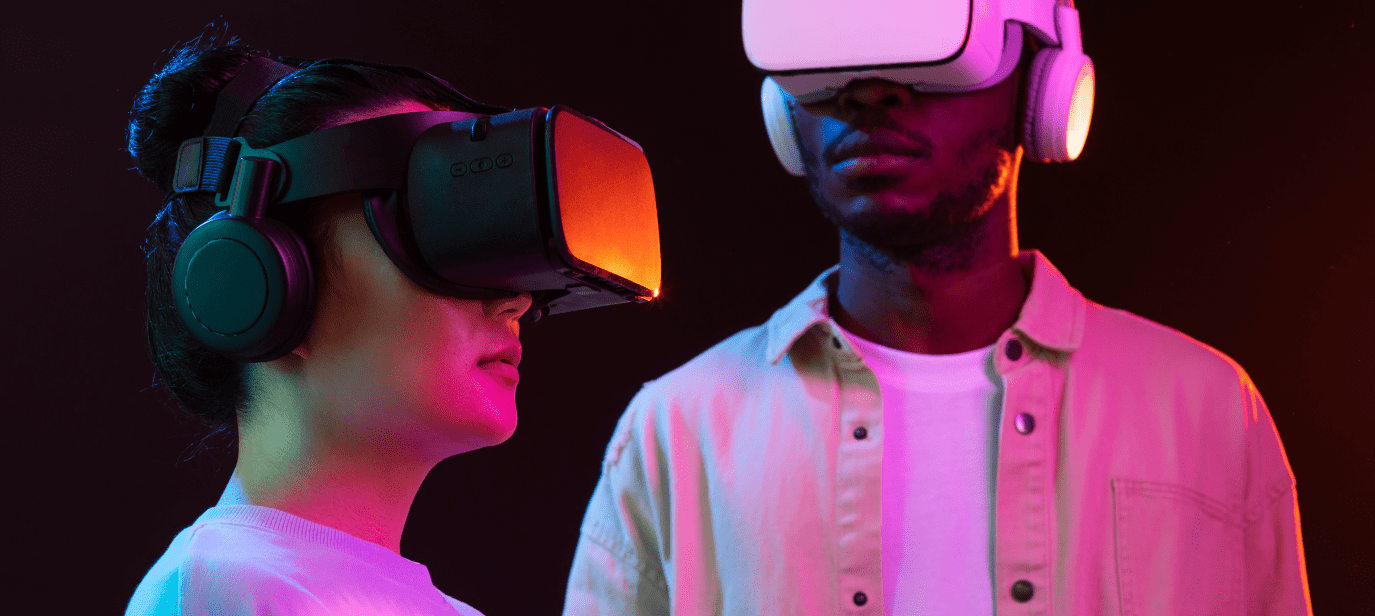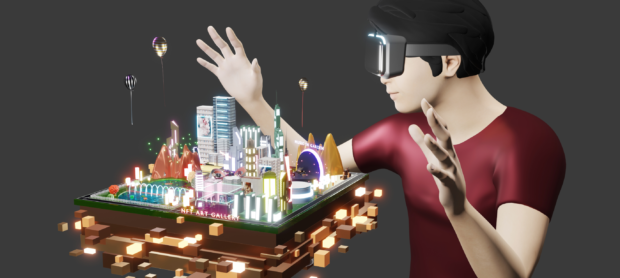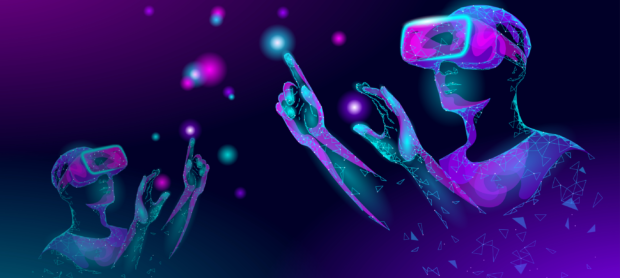Recent advancements in augmented reality (AR) and virtual reality (VR) technology have captured the interest of both consumers and companies. While VR entirely submerges users in a synthetic, three-dimensional world, AR overlays digital information over the actual world to improve the user’s perspective of their surroundings. These ground-breaking innovations have the power to change whole sectors and the way we engage with digital material.
The goal of this article is to examine the difficulties and restrictions that AR and VR technologies now encounter as well as their effects on a range of industries, including entertainment, remote communication and collaboration, commerce, and industry. We want to provide complete knowledge of how these cutting-edge technologies are transforming the way we live, work, and play by exploring current advances and potential future directions.
Although AR and VR technologies have amazing promise, there are still a number of obstacles and constraints that prevent their broad use and incorporation into our everyday lives.
Obstacles of a technical nature.
1. Hardware constraints: A salient stumbling block for augmented and virtual reality technologies is the requirement for robust hardware, providing vivid, immersive experiences. Potent processing capabilities, effective battery longevity, and a streamlined device form factor are indispensable for a frictionless user encounter. Alas, present-day technological advancements grapple to reconcile these elements, frequently culminating in unwieldy devices, restricted battery duration, and lackluster performance.
2. Software constraints: A notable challenge resides in the generation of lifelike graphics and unbroken interactions for augmented and virtual reality applications. The intricate task of devising software that precisely traces and reacts to user maneuvers, proffers persuasive visual effects, and ensures fluid transitions amidst virtual and tangible environments necessitates ceaseless ingenuity and enhancement.
Approachability and economical considerations
1. Steep device and infrastructure expenses: The elevated price of augmented and virtual reality devices, alongside requisite infrastructure for deployment, constitutes an obstacle for myriad prospective users. Premium headsets and motion tracking apparatus can prove costly, circumscribing access for individuals and smaller-scale enterprises unable to warrant the expenditure.
2. Constrained availability in specific locales: Apart from financial impediments, augmented and virtual reality technologies might not be universally accessible, owing to insufficient infrastructure or restricted high-speed internet connectivity. This digital chasm further obstructs the pervasive embracement and evolution of these cutting-edge technologies.

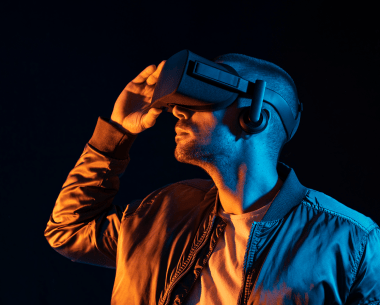
User experience and widespread adoption
1. Kinetic malaise and unease: A prevalent apprehension among augmented and virtual reality users concerns the likelihood of motion sickness and discomfort during protracted usage. Disorientation, stemming from discordance between the virtual milieu and users’ physical locomotion, can induce nausea and vertigo, deterring enduring utilization or adoption of such technology.
2. Apprehensions regarding privacy and security: As with any nascent technology, trepidations exist around the safeguarding of user data within augmented and virtual reality applications. Complications like unauthorized entry to personal data, breaches in security, and the possibility of surveillance spark debates on the ethical development and deployment of these avant-garde technologies.
AR/VR in the Entertainment Industry
The entertainment sector was fast to grasp the promise of AR and VR technologies, which led to important developments and creative uses across a range of subsectors.
Fully immersive video games
Storytelling and player engagement have been improved because of AR and VR technology, which provide players access to more interactive and immersive settings. A greater degree of engagement and connection between players and the game is made possible by improved narrative techniques paired with the capability to physically interact with the virtual environment.
The popularity of AR and VR in gaming has fueled the expansion of esports and the appearance of VR arcades, which have both been on the rise. Large crowds attend esports events where VR games are played, and VR arcades give the general public a convenient opportunity to try out the most recent developments in AR and VR gaming.
Virtual reality in movies and TV
The film and television industries have begun to use virtual reality (VR) technology for immersive storytelling, enabling viewers to explore virtual worlds and engage with the narrative in ways that aren’t feasible with traditional media. The audience will have a more interesting and tailored experience as a result.
New production methods and distribution strategies have been developed as a result of the use of augmented reality and virtual reality in movies and television. Characters may now be brought to life in movies using motion capture technology and virtual sets. Online distribution channels are meanwhile facilitating audience access to and consumption of VR content.

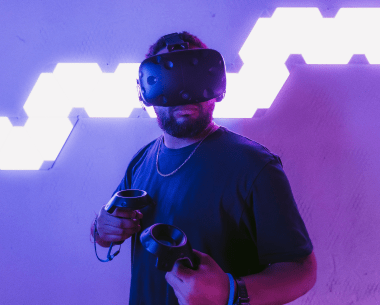
From Niche to mainstream: A Metamorphosis
As AR and VR technologies matured, their entertainment applications expanded and became increasingly accessible. The emergence of smartphones featuring built-in AR functionality—such as Apple’s ARKit and Google’s ARCore—placed AR experiences at the fingertips of countless users. The gaming industry seized upon AR’s potential, producing wildly popular games like Pokémon Go and Ingress.
VR, too, infiltrated multiple entertainment sectors, ranging from gaming and cinema to live events and amusement parks. Standalone VR headsets—exemplified by the Oculus Quest—eliminated the need for costly gaming PCs, rendering VR experiences more attainable for the masses. This transition from niche to mainstream unlocked untold opportunities for content creators and enterprises, setting the stage for AR and VR to revolutionize the entertainment world.
Role of AR/VR in Remote Collaboration and Communication
The breathtaking potential of AR and VR technologies looms on the horizon, poised to revolutionize collaboration and communication while bridging gaps and fostering immersive experiences across diverse industries.
Engaging Virtual Conferences and Gatherings
1. Real-time interaction and collaboration: By imitating face-to-face interactions, AR and VR technologies allow more successful virtual meetings and conferences. In order to improve communication and cooperation, participants may interact with one another in real-time while using gestures, body language, and spatial audio.
2. Lessening the need for actual travel: As immersive alternatives to in-person rendezvous, AR and VR technologies dissolve the need for physical travel. This conservation of time and money, paired with the reduction of carbon emissions, promises a more sustainable future.
Boundless Education and Training
1. Immersive classrooms and vivid simulations: AR and VR technologies hold the key to unlocking new dimensions in learning. Virtual classrooms and hands-on simulations invite students to participate in interactive activities, explore uncharted territories, and mingle with instructors and peers in real-time, enriching their educational experience.
2. Global expertise, within reach: By harnessing the power of AR and VR, students and professionals gain access to a cornucopia of resources and expertise from every corner of the globe. Remote collaboration with subject matter connoisseurs and exposure to diverse perspectives spark innovation and elevate educational outcomes.

The Realm of Social VR Platforms
1. Creating online communities and nurturing relationships: Social VR platforms wield AR and VR technologies to weave immersive online communities, fostering interaction, collaboration, and meaningful connections. These platforms stand poised to redefine the way we form relationships and socialize in the digital era.
2. A canvas for creativity and shared moments: Social VR platforms present users with unparalleled opportunities for creative expression and shared experiences. From virtual art galleries and performances to collaborative design endeavors, AR and VR technologies unfurl a new world of artistic expression and cultural communion.
AR/VR in Business and Industry
A wide range of companies is currently using AR and VR technology to improve different areas of their operations, demonstrating the potential uses of these technologies beyond entertainment and communication.
Designing and prototyping products
1. Virtual mockups and simulations: Companies may develop virtual mockups and simulations of goods using AR and VR technology, allowing designers and engineers to see and interact with their work in three dimensions. Before spending money on actual prototypes, this helps in finding possible design problems, optimizing performance, and making data-driven choices.
2. Streamlined collaboration and iteration: AR and VR technologies simplify product design and prototypes by enabling real-time collaboration amongst team members in various locations. This facilitates quicker iteration, cutting down on the time and expense involved in product development.
Onboarding and training new employees
1. Experiences that are fully immersing: AR and VR technology may provide workers with fully immersing learning opportunities that closely resemble real-world situations. Compared to conventional approaches, this hands-on approach to training improves information retention and aids in the development of practical skills.
2. Customizable training settings and scenarios: Companies may design environments and scenarios for augmented reality (AR) and virtual reality (VR) training to meet their particular demands. This enables a more focused approach to skill development and personnel development.

Retailing and marketing
1. Virtual showrooms and augmented product displays: AR and VR technologies are revolutionizing the retail industry by providing virtual showrooms and enhanced product displays. A more interesting and educational shopping experience may be had by consumers when they virtually try on clothing, virtually examine furnishings in their homes, or investigate interactive product demos.
2. Personalized shopping experiences and targeted promotions: Shopping experiences that are customized to the customer’s tastes and browsing history may be created using AR and VR technology. Customers can then get targeted product suggestions and promotions. This helps merchants increase sales and improve their marketing methods while also improving the consumer experience.
Conclusion
In the course of this article, we’ve delved into the intricate challenges and constraints inherent in AR and VR technologies while also examining their profound influence on a multitude of sectors, such as entertainment, remote collaboration, and communication, not to mention business and industry. Despite the formidable obstacles, these avant-garde technologies exhibit extraordinary promise in reshaping the manner in which we live, labor, and engage in leisure activities, thereby paving the way for expansion and ingenuity across a plethora of domains.
As the relentless march of progress propels AR and VR technologies forward, it grows ever more crucial for individuals and organizations alike to remain apprised of the shifting landscape, adjusting their sails accordingly. Harnessing these formidable technologies enables businesses to unveil unprecedented strata of efficiency, captivation, and immersive experiences for clientele and workforce alike.
Do you want to make your AR or VR concept a reality? Our highly skilled professional staff at Eventyr is prepared to assist you in making your idea a reality. We’ll lead you through the procedure while following your instructions and offer professional support at each stage. Please if you’d like more details and to learn how Eventyr can assist you in using AR and VR to accomplish your objectives.
